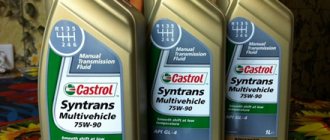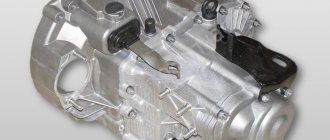21.01.2020
| (Votes: 1, Rating: 5) |
Issues discussed in the material:
- What are the differences between synthetics and semi-synthetics?
- Viscosity characteristics of synthetic and semi-synthetic oils
- Which motor oil is better: synthetic or semi-synthetic?
- Is 5w40 synthetic different from 10w40 semi-synthetic?
- Is it permissible to mix synthetic and semi-synthetic oils?
- Rating winner semi-synthetic motor oil 10w40
- Rating winner synthetic motor oil
“Synthetic or semi-synthetic?” - such a question, along with “spikes or Velcro?” will worry car enthusiasts as long as cars use internal combustion engines and wheels. At first glance, it may seem that synthetic oil is better: it is richer in additives and more expensive. So it's better quality?
In fact, it is impossible to answer this question unequivocally, since, in addition to the lubricant itself, there are other, important factors: manufacturers’ recommendations, the condition of a particular engine, driving style, weather conditions and much more. In our material we will analyze in detail the difference between synthetics and semi-synthetics.
Difference between synthetic and semi-synthetic
The purpose of motor oil is to reduce the negative impact of friction forces on engine parts. Lubricant begins to flow to the components of the power unit when it starts. The more effectively the oil copes with the friction force, the longer the engine elements will last and the less fuel consumption will be.
The list of tasks that motor oil solves includes another important item. It must ensure the cleaning of engine parts from metal particles formed as a result of mechanical friction, as well as from various deposits that form during fuel combustion. The cleaning function is performed by special additives included in motor oils.
Synthetics
Synthetic oil, as its name implies, is artificially created. For its production, petroleum products and various additives are used, which provide the necessary characteristics of the lubricating mixture. The technology for producing such oil involves changing the liquid at the molecular level.
Advantages of synthetics:
- Effectively copes with temperature changes.
- Significantly extends the service life of power units. If you choose the right oil according to its characteristics, then the answer to the question of which oil is better: synthetic or semi-synthetic, will be synthetic. This product will contain all the necessary additives and components.
- It copes better with severe operating conditions (idling, starting and warming up the engine) when the engine lacks oil.
- Can operate in various weather conditions and a wide range of temperatures. Oils such as 5W30 and 5W40 can be considered universal lubricants for engines.
- Reduces engine fuel consumption. Synthetics can easily penetrate into the smallest gaps and work out more slowly.
Most often, car owners refuse synthetics only because of its cost. This factor is considered the most significant drawback of this lubricant.
Semi-synthetics
This lubricating fluid consists of mineral oils and special additives (there are much fewer of them than in synthetics). It should be clarified that the mineral base for the production of motor oils can be of different classes. For synthetics, mineral oil of a higher category is used. The line of semi-synthetic oils does not contain PAOs or esters. With regard to semi-synthetics, there are no strict standards for the ratio of the volumes of the mineral base and additives (the content of components can be 55 x 45, 70 x 30, etc.). Unlike synthetics, semi-synthetics do not tolerate severe frosts. In addition, lower additive content reduces the oil's resistance to oxidation. Semi-synthetic lubricants, in terms of their characteristics, occupy a middle position between affordable mineral water and expensive synthetics. Due to the optimal price/quality combination, semi-synthetic oil is very popular among motorists. This lubricant is especially often used for cars with high mileage.
As a compromise between mineral water and synthetics, semi-synthetic oil has a number of advantages:
- provides all the necessary conditions for normal operation of the motor;
- protects engine parts from wear;
- has high penetrating abilities;
- has optimal pour point temperatures (semi-synthetics 5W30 and 5W40 are available for sale);
- demonstrates low evaporation rates;
- has good technical performance;
- affordable (almost 1.5 times cheaper than synthetics).
The disadvantage of semi-synthetic oil compared to synthetics can be considered lower efficiency and higher consumption. In addition, synthetic lubricants cope better with the harsh operating conditions of engines.
How does lubrication work?
Motor oil is designed to reduce friction between parts of the power unit. It begins to flow from a special compartment the moment the car is started. The better the lubricant reduces friction, the less gasoline is consumed and the less wear on engine parts.
But this is not the only task of modern fuels and lubricants. Also, a high-quality substance should clean the engine of deposits, fumes formed during fuel combustion, and iron shavings that are created from the friction of parts. Special substances called additives are responsible for this.
Synthetic engine oil is artificially created fuel and lubricants. Without going into the details of production, it can be represented as follows: oil is taken, as well as other substances responsible for certain properties of the future lubricant, and mixed using a special technology, in which the molecular structure of the entire liquid changes.
Semi-synthetic is made by mixing additives, mineral oil, which is refined petroleum. Its cost is lower, which affects the market price. This is the main difference between synthetics and semi-synthetics.
Oil viscosity parameters
The most important characteristics of motor oil is the viscosity index. Taking this parameter into account, members of the SAE community have formed standards that guide modern brands that produce fluids for automobile engine lubrication systems. The packaging of motor oil must be marked with alphabetic and numerical symbols (for example, 5W30). The symbol indicates winter operating conditions, and the number following it determines the temperature value at which the oil begins to thicken and cannot circulate through the engine lubrication system.
In our example, the number 5 before the W symbol shows the minimum temperature value at which a cold engine can be started and lubricant can be pumped through the system by an oil pump in such a way as to avoid dry friction of engine parts. This temperature in our case will be -35 °C (you need to subtract 40 from the first digit). If we subtract 35 from the number before the W symbol, we get the critical temperature at which the motor can be started (for our example this is -30 °C). As you can see, the larger the number in front of the letter symbol, the less resistant to frost the motor oil will be. If it is generally 0 °C there, this means that the minimum temperature at which the pump can pump such oil is minus 40 °C, and the starter will spin and start the engine at a minimum of -35 °C (provided that the starting mechanism is in normal technical condition and battery).
We recommend
“Semi-synthetic oil: description and composition” Read more
The number 30 after the W symbol in our case demonstrates the high-temperature viscosity of the lubricant (minimum and maximum viscosity at temperatures from 100 to 150 °C). The higher this number, the more viscous the oil will be at high temperatures. The optimal high-temperature viscosity of the lubricant is determined by the manufacturer of the specific model of the power unit. In this regard, we recommend that when choosing engine oil for your car, you should focus on the characteristics specified by the manufacturer in the vehicle’s operating instructions.
To determine the degree of viscosity of motor oil, the international standards SAE J300 are used today. According to this system, all lubricants for internal combustion engines are divided into three types: winter, summer and all-season. The first type includes motor oils marked SAE 0W, SAE 5W, SAE 10W, SAE 15W, SAE 20W. The packaging of the summer lubricating fluid contains the markings SAE 20, SAE 30, SAE 40, SAE 50, SAE 60, and the all-season lubricant contains the markings SAE 0W-30, SAE 0W-40, SAE 5W-30, SAE 5W-40, SAE 10W-30 , SAE 10W-40, SAE 15W-40, SAE 20W-40. All-season oils are the most popular, universal product today. Their characteristics are optimal for different operating temperature conditions, so we can talk about the practicality of such lubricants.
The table shows the most common viscosity markings for synthetic and semi-synthetic motor oils.
| SAE viscosity grade | Explanation – temperature range, °C |
| 0W20 | -35…+10–15 |
| 0W40 | -35…+35 |
| 5W20 | -25…+10–15 |
| SAE 5W30 | -25…+20 |
| 5W40 | -25…+35 |
| 5W50 | -25…+45 and above |
| 10W30 | -20…+30 |
| 10W-40 | -20…+35 |
| 10W60 | -20…+45 |
| 15W-30 | -15…+35 |
Synthetics and semi-synthetics not only have different compositions, but also different viscosity values. Which oil to choose for your car? You need to take into account the year of manufacture of the car. For cars with mileage of more than 200 thousand km, it is worth choosing a thicker lubricant. Viscous engine oil will be able to compensate for increased clearances, which will have a positive effect on engine performance. The engine of a new car should be filled with less viscous synthetic oil, which will easily penetrate minimal charges.
Selection rules
Drivers who use a domestic semi-synthetic product do not always end up losing. Unfortunately, even expensive compounds can negatively affect the functioning of the turbine, valves and other components of the propulsion system. To keep your car looking its best, you need to research the selection criteria and the main points to pay attention to. Each brand has developed special security mechanisms to prevent the purchase of counterfeits.
For example, original Castrol oil is distinguished by the presence of:
- laser engraving on the surface of the lid;
- foil on the neck of the container;
- hologram on the inside of the lid;
- exclusive license plate located under the label;
- sticker with a hidden hologram with a unique verification code.
ZIK products have added to the listed degrees of protection:
- measuring scale;
- thermal film on which the logo is applied, which is placed on the lid;
- complicated canister shape.
Ravenol chose to choose an unusual way to protect its products. The hologram is marked. It can only be detected using ultraviolet light.
The verification code has a scratch layer. All of the above methods are used by different manufacturers. Recently, people have begun to choose verification using an SMS code in an online format.
In addition, when purchasing such products you need to take into account the following characteristics:
- engine structure;
- car mileage;
- the type of filter used;
- temperature conditions in which the composition is used;
- type of fuel, its properties, density;
- technical condition of the motor.
Such moments can affect the service life of the oil fluid, the volume that needs to be filled, and more.
Which is better: synthetics or semi-synthetics?
Which oil is better to choose: synthetic or semi-synthetic? Answering this question is not as easy as it might seem at first glance. Synthetic oil has more attractive characteristics, but semi-synthetic oil is also a very high-quality product. At a certain mileage it is worth switching to semi-synthetics. The moment for such a transition can be determined based on the condition of the motor and its service life, which is set by the manufacturer. In the lubrication system of an engine with high mileage, synthetic oil begins to burn more. But this process does not always take place. The main characteristic when choosing a motor oil is the tolerances of the motor oil according to the international certification system.
If you want to switch from one type to another and are trying to figure out: synthetic or semi-synthetic – which is the best oil for your car’s engine, we recommend conducting a small test in the winter. Fill with new oil and carefully observe the engine's operation. See if it “gobbled up” the lubricating fluid after 1,000 km, as well as after 7–8 thousand km. If the results of observations are disappointing, it is worth returning to semi-synthetics again.
This experiment will not harm your car.
We recommend
“Do I need to change the oil after winter: all the pros and cons” Read more
The inscription on the packaging indicates whether the motor oil belongs to one type or another:
- Semi Synthetic is a semi-synthetic product containing more than 50% synthetic additives.
- The packaging of synthetics always says Fully Synthetic. Synthetic oil marking:
- Synthetically Fortified – a fortified product containing no more than 30% synthetic additives;
- Synthetic Based – additives less than 30%;
- Synthetic Technology – synthetic additives up to 50%.
Note!
When choosing lubricants, it is worth reading or viewing product reviews from independent research laboratories. For example, on the “hydrocrack” they say that conventional synthetics are inferior in characteristics to PAO synthetics, but such information may not be available on the packaging. Manufacturers may add about 5-10% PAO and call their PAO product a synthetic. Laboratory tests are the best information for choosing the right engine oil.
Results. Brief answers to all questions.
- What is the difference between synthetics and semi-synthetics? Answer: As base oils and additive packages. Synthetics have premium base oils and a larger additive package, so they are more stable in every sense.
- What's better? Answer: Synthetics are better in all respects. You need to answer the question for yourself, why spend more on synthetics if the car feels great on semi-synthetics? If it makes sense to you, then feel free to move on.
- Is it necessary to flush the engine? Answer: Not necessarily. Optional. You can shorten the first interval to 3000 km and skip the flushing.
- Is it possible to mix? Answer: You can, but it is not necessary. All motor oils are compatible with each other, but no one can give you a guarantee that everything will be smooth after mixing. I advise you not to ride for a long time on such a mixture.
- What's better in winter? Answer: Definitely synthetic. But we remember about expediency; in frosts down to -20, semi-synthetics also work great.
Synthetic 5w40 or semi-synthetic 10w40 - is there a difference?
Let's figure out which oil is better: synthetic or semi-synthetic, using the example of the most popular products labeled 5w40 and 10w40. Lubricant 5w40 is considered a classic option. Both synthetics and semi-synthetics can have such viscosity indicators, so you need to carefully study the information on the packaging so as not to make a mistake with your choice. A universal lubrication option would be 5w40 all-season motor oil. Let's look at its features:
- can be used for most types of internal combustion engines (gasoline, diesel, turbocharged engines, etc.);
- has high viscosity characteristics (in the marking this parameter is indicated by the number 40);
- 5w symbols on the packaging indicate that this liquid can be used in severe frosts, when the temperature reaches -30 ℃.
Motor oil 10w40 is semi-synthetic. It differs from synthetic fluid in the number of additives, production and purification technologies. Its features:
- just like 5w40 oil, this lubricant is all-season and can work effectively in all weather conditions;
- due to its high viscosity and density, 10w40 oil is capable of forming a stable protective film on engine parts;
- can work in frosty conditions: the number 10 before the w symbol indicates that the lubricant retains its characteristics at temperatures down to -25 ℃.
Let's look at the main differences between 5w40 synthetic oil and 10w40 semi-synthetic oil.
Both oils are labeled with the number 40, indicating their effectiveness when used in hot weather. They form a stable protective film on engine parts even at +40 ℃. The difference is that 5W40 synthetics will be more fluid at high temperatures, which will lead to increased oil consumption.
Motor lubricants, the last number in the labeling of which is 40, may have slight differences in characteristics only if the liquid of different brands is compared.
In the table we have listed the most important parameters of 5w40 and 10w40 motor oils, which allow us to more clearly examine their differences and similarities:
| Characteristic name | 5W40 | 10w40 |
| Basic basis | Synthetic oil | Semi-synthetic oil |
| Operating temperatures | -30…+40 ℃ | -25… +40 ℃ |
| Starter crankability at minus limit | 6600 mPa-s | 6600 mPa-s |
| Pumping force through the system at the minimum permissible temperature | 60000 mPa-s | 60000 mPa-s |
| Kinematic viscosity at 100 °C | From 12.5 to 16.3 mm2/s | From 14 to 16.3 mm2/s |
| Viscosity at 150 °C and shear rate | Not less than 2.9 mPa-s | Not less than 2.9 mPa-s |
| In what engines is it used? | New or low mileage, in areas with frosty winters | Any internal combustion engine with medium and high mileage |
| Flash point | 229 ℃ | 205 ℃ |
| Limit pour point | —39 ℃ | —33 ℃ |
| Sulfated ash content | 1.1 % | 1.2 % |
| Base number | 7.3 mgKOH/g | 9.6 mg KOH/g – 11.4 mg KOH/g |
Is it possible to mix synthetics and semi-synthetics?
What happens if you pour semi-synthetic oil into synthetic oil? On this score, the opinions of motorists are divided. Some people believe that these oils should not be mixed. This opinion is based on the fact that for some reason manufacturers developed a classification of lubricants. Since synthetics and semi-synthetics have different compositions, mixing them may lead to negative consequences.
Opponents of this opinion believe that the division of motor oils into synthetic and semi-synthetic is purely marketing in nature and can be mixed.
Experts on this matter say the following: if you care about your own car, then you can mix synthetics and semi-synthetics only in exceptional cases. In this case, the oils must be of the same brand. Particular care should be taken when mixing liquids with different viscosities.
Motor oils from the same manufacturer have a similar chemical formula and a slightly different set of additives. By mixing technical fluids from the same manufacturer, you can be sure that they will not conflict with each other.
If you couldn’t find a product from the right manufacturer to add oil to the engine, you should choose a lubricant that is similar according to international criteria. The API and ACEA standards systems provide for the possibility of mixing oils from the same group according to API and ACEA standards, but they can also belong to different categories. Engines manufactured from 2000 to 2004 operate well on API SL oils. It is better to fill power units of 2004–2009 with SN and Low SAPS oils. The second option is more suitable, since this oil has an energy-saving composition and goes well with modern exhaust systems.
Of course, it is better to mix motor oils with the same viscosity characteristics. If it is not possible to add fluid with the same viscosity, you need to select a lubricant from one manufacturer. The engine can run with this oil mixture until the next oil change without much risk, but such situations should still be avoided.
It is worth considering that if you mix lubricants of different classes, the final viscosity of the liquid will decrease. For example, if you add class H fluid to class L motor oil, the mixture will have the characteristics of class H, even if the higher class lubricant has a much larger volume. Since the oil mixture will be of lower quality, the fluidity of the lubricant will also deteriorate, so its access to engine parts will be difficult.
The characteristics of the final mixture of oils of different quality depend on the products of which brands were used. If this lubricant is produced by a manufacturer that was originally recommended by the car manufacturer, then we can say with confidence that the engine is not in danger.
This factor should be taken into account when answering the question of how semi-synthetics will behave after synthetics in the engine of your car. Using motor oil of different classes, differing in viscosity and produced by different brands can lead to trouble. A car engine using such lubricant will run intermittently, and over time, serious damage may occur.
If you often mix different oils in an internal combustion engine, then deposits will form on the parts and internal walls of the engine, accelerating the wear of components and parts. If the car owner does not think about what he is pouring into the lubrication system of the power unit, then over time a sudden breakdown of the car is possible.
When you doubt whether it is possible to add a certain oil to the engine of your car, you should take the advice of professionals. They recommend conducting a test by mixing and heating a small amount of available lubricating fluids. You can even heat the mixture with a lighter, observing fire safety rules.
We recommend
“The oil pressure light came on: we are looking for and eliminating the cause” More details
If, when heating mixed oils, rapid formation of foam is observed, a noticeable sediment is formed, or other negative phenomena are present, then you cannot mix liquids in the lubrication system of the car’s engine. If no noticeable reaction is observed, then the mixture will not cause damage to the power unit.
Content:
- Introduction
- What is the difference between synthetic and semi-synthetic oil?
Features of synthetic oil
- Features of semi-synthetic oil
- Would mineral oil be better?
The best semi-synthetic oil 10w40
Here is a rating of the best fluids for car engine lubrication systems labeled 10w-40.
G-Energy expert G
This semi-synthetic oil was created in such a way as to ensure improved performance characteristics and increased power of engines that have run more than 100 thousand km. In other words, this motor oil is designed for high mileage engines.
G-Energy lubricant differs from competitors' products in its ability to provide stable pressure in the lubrication system and effectively protect seals from drying out and destruction. In addition, the advantages of this semi-synthetic material include its high environmental friendliness.
Testing of G-Energy 10w 40 motor oils has shown that they provide easy engine starting even in severe frosts.
The disadvantages of this product include two factors:
- products have a small number of approvals from automakers;
- The oil is recommended only for used engines.
If the operating and maintenance instructions for your car model indicate that you can use G-Energy motor oil, then feel free to buy this product. Stable and easy engine starting contributes to effective protection of the motor from wear and sludge formations.
ZIC X5
ZIK engine oil is well known to car enthusiasts all over the world. It consistently confirms its quality and performance characteristics. ZIC lubricant was developed by SK Energy, which is a leader among Korean manufacturers and is aimed at car engines produced in the USA, Japan and Korea. ZIK engine oil is poured into internal combustion engines that come off the assembly lines of Hyundai and Kia factories.
Compared to motor oils from competing brands, ZIC X5 has a number of features:
- ZIK lubricant neutralizes destructive acids;
- The oil is evenly distributed over the surface of the engine parts, which ensures its stable operation even under high loads.
The advantages of ZIC products include the ability to maintain viscosity in cold and hot weather. This feature ensures free movement of parts and easy cranking of the crankshaft in severe frost. Experts also note the cleaning characteristics of Korean motor oil, which removes various contaminants from the lubrication system. ZIC X5 oil is consumed moderately during operation of the power unit, and it does not have to be topped up from replacement to replacement.
ENEOS Super Gasoline SL Semi-Synthetic
In third place in the rating of 10w40 motor oils is the Japanese semi-synthetic Nippon Oil. The product name Eneos comes from a combination of the words energy (energy) and neos (new). ENEOS Super Gasoline SL Semi-Synthetic lubricant is produced using the most modern technologies. Its developers set the task of increasing the power of automobile engines.
Nippon Oil motor oils performed excellently during engine operation under load, regardless of weather conditions. They fully confirm the characteristics declared by the manufacturer and are able to maintain the performance of power units in any conditions. The lubricant effectively copes with overloads, so we recommend it to car enthusiasts with an aggressive driving style.
Best synthetic oil
Mobil 1 FS 0W40
The most famous synthetic motor oil, Mobil 1 FS 0W40, has improved performance characteristics; previously this product was called Mobil 1 0W40. He passed many different tests successfully. The most indicative is the test project conducted by ExxonMobil in the Russian capital in 2014. This project lasted a year and a half and consisted of testing oil on taxi engines operating in extreme conditions. The tests involved Mobil 1 0W40 and Mobil 1 ESP Formula 5W-30 lubricants. Both products performed great. After inspecting the engines, experts noted the excellent condition of the internal combustion engine parts. For evaluation, a scale from 0 to 10 was used, where 0 is a new motor, and 10 is the most slagged unit. Motors filled with Mobil synthetics received 0.5 points. After disassembling the internal combustion engine, experts noted the high cleanliness of the parts.
Advantages of Mobil synthetics:
- reliable protection of engine parts from wear;
- excellent cleaning characteristics prevent the formation of deposits as a result of oxidation and corrosion;
- the oil retains its characteristics even over long distances up to 25,000 km;
- increasing the power and efficiency of the power unit;
- reduction of fuel consumption;
- stable performance characteristics under overloads and temperature changes;
- reduction of emissions into the environment.
Like other well-known brand motor oils, Mobil 1 is often subject to counterfeiting. To protect yourself from purchasing counterfeit products, you should buy products only from official dealers who have all the necessary certificates.
Shell Helix Ultra 5W40
The popular synthetic motor oil from the well-known manufacturer Shell constantly ranks first in various ratings. In 2018, the synthetics of this brand received the status of a revolutionary product. The test results confirm the opinion of car enthusiasts that Shell oil is one of the best products. This is the only synthetic that is officially recommended by the Ferrari concern, which confirms its highest level. We did not give Shell Helix Ultra synthetics the first line of the rating only because of the high price, but we note that the excellent characteristics of this lubricant allow us to turn a blind eye to the price tag.
Advantages:
- reliable protection of engine parts from wear even with an extended oil change interval;
- high degree of stability of performance indicators;
- increased engine performance, smooth operation;
- increasing the service life of the motor;
- ensuring the cleanliness of the piston group at the factory level;
- easy engine starting in cold weather (up to -40 °C);
- stable structure of components even under high loads and temperature changes;
- low waste consumption;
- economical fuel consumption.
The disadvantages of Shell motor oil include its high cost, but this is compensated by the corresponding quality. In addition, it is worth noting that Shell products are often counterfeited.
Motul 8100 X-cess 5W40
Universal synthetics from the French brand Motul are always at the top of the motor oil ratings. Motul 8100 X-cess 5W40 can be used in lubrication systems of various types of internal combustion engines (gasoline, diesel, equipped with gas equipment, etc.). This engine oil is especially suitable for powerful power units with direct fuel injection, turbocharging and exhaust gas aftertreatment systems (catalysts and particulate filters).
Advantages:
- reliable protection of engine parts from wear;
- high degree of stability of performance indicators;
- high pumping speed through the lubrication system and complete coverage of engine parts;
- protection against oxidation;
- stability of performance characteristics during temperature fluctuations;
- increase in engine life;
- economical fuel consumption;
- gentle care of exhaust gas neutralization systems;
- environmental friendliness;
- admissibility of mixing with different types of motor oils.
It may seem that Motul synthetics are very expensive. In addition, counterfeits of this product are quite common.
What do car enthusiasts choose: synthetics or semi-synthetics?
- What is better for a used engine “Many people believe that it is better to choose semi-synthetics, but this is not so. My car has already traveled a couple of hundred thousand km. She is already over 12 years old. Now I only fill the engine with Esso synthetic (the previous owner says he used Shell). The oil doesn’t burn, doesn’t leak, expansion joints don’t knock, and most importantly, the car starts easily in any frost.”
- If the engine is in poor condition
“It’s no secret that synthetic oil leaks faster through a worn oil seal than mineral oil. I’m tired of spending money on Castrol and recently replaced all the oil seals. But please note that semi-synthetics are essentially mineral water, only with additives.”
I’m tired of spending money on Castrol and recently replaced all the oil seals. But please note that semi-synthetics are essentially mineral water, only with additives.” - What to put in a car engine
“All motor oil manufacturers have approval codes. In accordance with such standards, they develop varieties and brands of their products, but pouring synthetics or mineral water is completely different criteria.”We recommend
“After changing the oil, the light comes on: possible causes and troubleshooting” Read more
- Winter and summer engine oil
“There is no guarantee that the additives found in motor oil will be equally effective if you need to add synthetic to semi-synthetic a couple of times a year. Flushing the system before changing the oil does not always help either.I advise all motorists to choose a universal oil for summer and winter, taking into account the weather, oil consumption, engine condition and driving style. Always pour only this kind of oil.”
- How to distinguish a fake
“Identifying fake motor oil is not very difficult. It is distinguished by its low cost and packaging. Look at the shape of the canister. In fake oil, as a rule, the jar does not have such clear outlines. This is especially noticeable on corrugations (fuzzy edges, broken geometry of the pattern), on stiffening ribs, which will be softer (they are easy to deform). In addition, the color of the jar will be at least slightly different from the packaging of the original oil. Reliable manufacturers use not only expensive containers, but also high-quality stoppers, which serve as additional protection against counterfeiting.”











